

Uma nova onda de ferramentas de wireframing e prototipagem. Como designer de interação, você deve ter o seu próprio arsenal de ferramentas preferidas para representar interfaces e demonstrar hierarquia, navegação, transições e como ela se comporta à medida em que o usuário interage com ela.
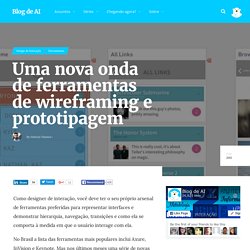
No Brasil a lista das ferramentas mais populares inclui Axure, InVision e Keynote. Mas nos últimos meses uma série de novas ferramentas vem ganhando notoriedade na comunidade de UX aqui dos EUA – e virando alvo de discussão em fóruns online e assunto de workshops e treinamentos em várias cidades do país. Treatise on User Experience Design: Part 1.
User experience design is the liaison between the three areas of technology, business, and design.
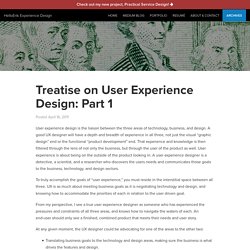
A good UX designer will have a depth and breadth of experience in all three, not just the visual “graphic design” end or the functional “product development” end. That experience and knowledge is then filtered through the lens of not only the business, but through the user of the product as well. User experience is about being on the outside of the product looking in. UI/UX projects on Behance. As disciplinas e as indisciplinas de UX. Eu trabalho com Experiência do Usuário há quase 10 anos, desde quando pedi demissão do meu emprego de webdesigner para virar um consultor especializado.
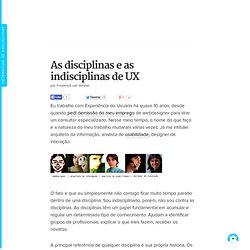
Nesse meio tempo, o nome do que faço e a natureza do meu trabalho mudaram várias vezes. Já me intitulei arquiteto da informação, analista de usabilidade, designer de interação. Tendência de UI: Flat Design - Choco La Design. Flat UI Design. Pttrns — Mobile User Interface Patterns. Smashing UX Design — Usability, Psychology and Information Architecture.
Category: UX Design This category features quality articles on usability, information architecture, interaction design and other user experience (UX) related topics – for digital (Web, mobile, applications, software) and physical products.
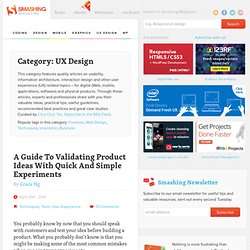
Through these articles, experts and professionals share with you their valuable ideas, practical tips, useful guidelines, recommended best practices and great case studies. Curated by Chui Chui Tan. . Designing With Sensors — Creating An Adaptive System To Enhance UX. Advertisement In computer science, the term “adaptive system” refers to a process in which an interactive system adapts its behavior to individual users based on information acquired about its user(s), the context of use and its environment.
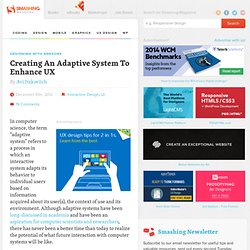
Although adaptive systems have been long-discussed in academia1 and have been an aspiration for computer scientists and researchers2, there has never been a better time than today to realize the potential of what future interaction with computer systems will be like. The abilities of today’s network information technologies to create rich, immersive personalized experiences to track interactions and aggregate and analyze them in real time, together with the data collected by the sensors we carry in our smart devices, provides us an opportunity like never before to design adaptivity in order to ultimately offer a better user experience that is both unobtrusive and transparent.
Examples Of Adaptive Systems. Inspiration — Adding A Personal Touch To Your Web Design. Advertisement The Web is technical by nature.
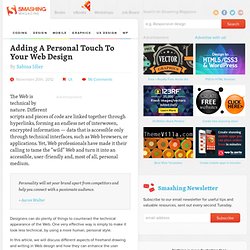
Different scripts and pieces of code are linked together through hyperlinks, forming an endless net of interwoven, encrypted information — data that is accessible only through technical interfaces, such as Web browsers, or applications. UX Design Q&A — Adaptive Vs. Responsive Layouts And Optimal Form Field Labels. Advertisement Editor’s note: Welcome to a new column in the UX Design section on Smashing Magazine!
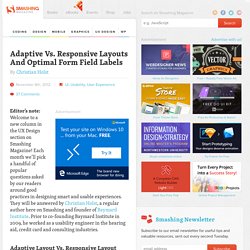
Each month we’ll pick a handful of popular questions asked by our readers around good practices in designing smart and usable experiences. Defining and Informing the Complex Field of User Experience (UX) Embracing the UX Spectrum. As an industry, we have the tendency to think and talk about user experience design in either a Web or a software context, where the demand to humanize complex interactive systems has been the highest.
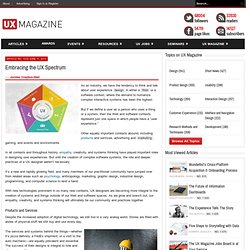
But if we define a user as a person who uses a thing or a system, then the Web and software contexts represent just one space in which people have a “user experience.” Other equally important contexts abound, including products and services, advertising and marketing, gaming, and events and environments. In all contexts and throughout history, empathy, creativity, and systems thinking have played important roles in designing user experiences.
But until the creation of complex software systems, the role and deeper practices of a UX designer weren’t necessary. With new technologies prominent in so many new contexts, UX designers are becoming more integral to the creation of systems and things outside of our Web and software spaces. 5 lições aprendidas a partir de 100 mil estudos de usabilidade. Acontece o tempo todo. As pessoas ficam confusas, frustradas e com raiva ao usar sites. Elas suspiram, gemem e às vezes até mesmo gritam. Eu vejo isso acontecer com meus próprios olhos todos os dias. Learning to See. By Oliver Reichenstein Learning to design is learning to see, an adventure that gets more and more captivating the further you go. A love letter to my profession… Our mind is not a camera. Seeing is not a passive act. We see what we expect to see, or, as Anaïs Nin put it so beautifully: “We don’t see things as they are, we see them as we are.”
The idea that our perception is as much a result of what we are able to know as of what we expect to find is not new. “Up to now it has been assumed that all our cognition must conform to the objects; but […] let us once try whether we do not get further […] by assuming that the objects must conform to our cognition.”
In the meantime, cognitive psychology has followed Kant’s “Copernican Revolution-in-reverse”. “Perceptual set is a tendency to perceive or notice some aspects of the available sensory data and ignore others. […] perceptual set works in two ways: 1. The way expectation can influence our cognitive set can be illustrated quite easily: Aprendizados sobre User Experience em métodos ágeis. Por Fabricio Teixeira Vale começar o post dizendo que não sou especialista em Scrum, tampouco gerente de projetos.

Longe disso. Mas nos últimos meses tenho participado de projetos que usam “Scrum de verdade” e aos poucos fui anotando alguns aprendizados que podem ser úteis para outros profissionais de User Experience que estejam embarcando nas metodologias ágeis. O ponto é que apesar de muitos gerentes de projeto serem treinados em Scrum e possuírem certificação no assunto, muitas vezes nesse processo de certificação eles não aprenderam a liderar um time que possui profissionais de UX em sua formação. Convenhamos, User Experience é uma área relativamente nova e não são todos os times de design e desenvolvimento que possuem um especialista no assunto. 16 dicas para uma boa User Interface. Por Fabricio Teixeira Tente agrupar funções similares ao invés de fragmentar a UI Segundo o GoodUI.org, essas são as 16 dicas para uma boa interface: O projeto foi criado por Jakub Linowski, um designer que trabalha especificamente com otimização de performance de interfaces.
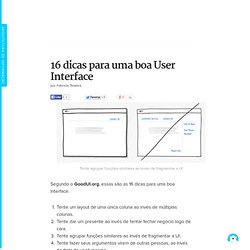
Para ver a lista completa com exemplos ilustrados: GoodUI.org. UX Links — Hints from the lazy bear.